slides: How Oregon and Ohio State Coaches Changed the Game by Running the Spread Offense





 Email to a friend
Permalink
Email to a friend
Permalink
Saturday, January 10, 2015
Taya Alami, GoLocalPDX Contributor
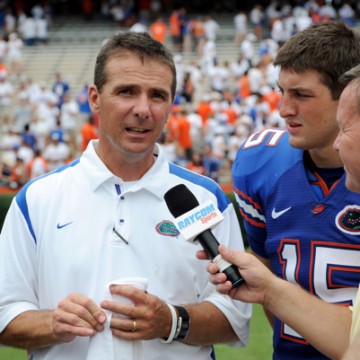
Urban Meyer as the head football coach at the University of Florida. Heisman Trophy-winner Tim Tebow look on.
Over the past 10 years, there have been few football coaches on any level that have innovated the game more than the coaches at Oregon and Ohio State.
In 2004, Ohio State Coach Urban Meyer was the head coach at Utah. That season, Meyer led the Utes to an undefeated season and a BCS bowl win. Meyer's Utes put up huge numbers by running a spread-option attack, led by quarterback Alex Smith. They would line up with four wide receivers split far apart across the field. When the ball was snapped, Smith used mismatches and misdirection to stay a step ahead of opposing defenses.
Football fans across the nation were captivated by the excitement.
In The NFL draft later that spring, Smith was selected first overall by the San Francisco 49ers - a team that desperately needed to find a franchise quarterback. The selection legitimized spread-option quarterbacks, who were often seen by pro scouts as unsophisticated players who benefited from playing in a gimmick offense. Meyer, however, had designed an offense based on a read-and-react philosophies that overlapped with the the schemes used in the passing league of the NFL.
Chip Kelly, the architect of the Ducks' current offense was merely an unknown visionary at the 1-aa University of New Hampshire when Meyer was signing his deal with Florida.
Around the same time, the Ducks decided to run a spread offense of their own - the team hired Gary Crowton as its offensive coordinator in 2005, with disappointing results.
After Crowton left Eugene for Baton Rouge a few seasons later, the Ducks hired Kelly as his replacement.
The rest was history.
Together with current head coach Mark Helfrich and now-offensive coordinator Scott Frost, Kelly implemented a no-huddle, uptempo offense and new way of play-calling on his way to elevating Oregon to an elite-level of football. Kelly was eventually promoted to head coach, before being offered a lucrative deal to coach in the pros.
Meyer, on the other hand, won a national championship in 2006-07 coaching at the University of Florida. Meyer and the Gators hoarded wins while dominating in-state rivals, constructing the legend of Tim Tebow and laying a legacy that would be carried out by Meyer's contemporaries, like Mississippi State head coach Dan Mullen, who called plays for Meyer at UF before accepting his current job.
The spread offense has come a long way in the past decade. Because of Meyer and Kelly (and their assistants) the game of football will never look the same.
Related Slideshow: Slideshow: How Oregon and Ohio State Coaches Changed the Game by Running the Spread Offense
Here are some of the ways Oregon and Ohio State coaches changed the face of the game:

Prev
Next
Made Spread Quarterbacks Valuable to the NFL
Utah Quarterback Alex Smith was selected with the first overall pick in the 2005 NFL Draft. He signed a six-year, $49.5 million deal with the San Francisco 49ers.
Smith going number one brought the spread legitimacy at the next level.
The 49ers drafting a QB who ran Meyer's spread option attack in college did not fall flat on the rest of the league - the first quarterbacks selected in the next several drafts ran some form of the spread as well.
Thanks to Meyer, spread quarterbacks were escaping the "gimmick offense" label that had plagued players from other programs that ran four and five-wide receiver systems in college.
In the ten years that followed, NFL general managers began looking to spread-option gunslingers to save their franchises.
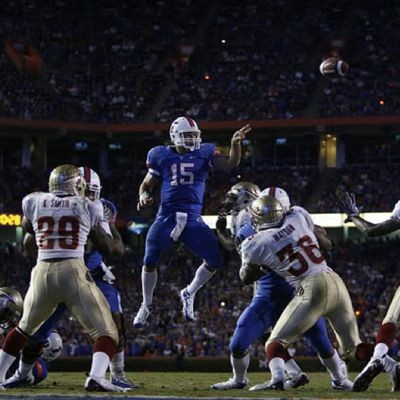
Prev
Next
Resurrected the Option
Ohio State Coach Urban Meyer and former Oregon Coach Chip Kelly added the option to the spread offense in several innovative ways.
Chip Kelly began running inside zone runs, optioning off of the defensive end, executing the spread option from the inside out (contrary to the philosophy of the offensive coordinator who preceded him).
Both Meyer and Kelly were able to incorporate the short passing game into their option attacks.
Meyer was able to design passes that were almost runs, like when Tebow would throw a dump pass to the tight end near the goal line. The Ducks were able to run their own variations of the run-pass option, like when Jeremiah Masoli would pull the ball from the arms of a running back and throw a lateral to a waiting wide receiver.
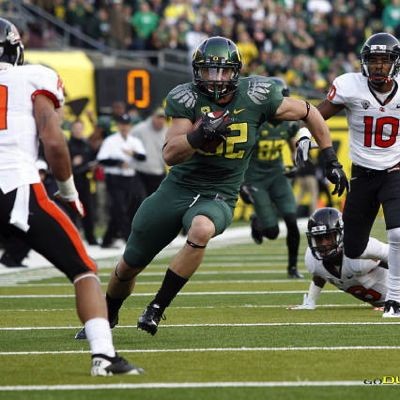
Prev
Next
Put Power Positions Back into Formations
For a long time, tight ends were a rarity in spread offenses, which were often ran in four and five-wide receiver sets.
When Meyer left Utah to take the head coaching job at Florida, he embraced certain aspects of old school football. Playing to his teams' talent, Meyer began implementing tight ends and fullbacks into some of his formations in an effort to beef up his running attack against SEC defenses.
The Ducks also embraced the tight end position, relying heavily on players like Ed Dickson, Colt Lyerla and Pharaoh Brown.
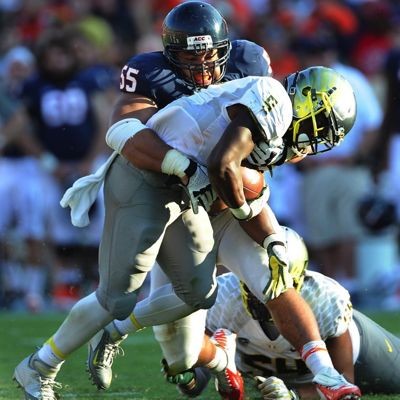
Prev
Next
Dumped Schemes that Weren't Working
Oregon was committed to running the spread before Chip Kelly's 2007 arrival in Eugene. Gary Crowton held the offensive coordinator before Kelly and also ran a spread option offense, albeit unsuccessfully.
Crowton's offense was overly dependent on presnap motion by receivers and running backs. Despite having talented running backs like Jonathan Stewart, opting to have a receiver carry the ball was common strategy. When the Ducks found themselves in third-and-long situations, they often just ran a screen pass or heaved the ball toward a crossing route down field, with mixed results.
It didn't work out. Crowton left Oregon and took the same position at LSU.
Chip Kelly stepped into the vacated offensive coordinator position at Oregon.
The rest is history.
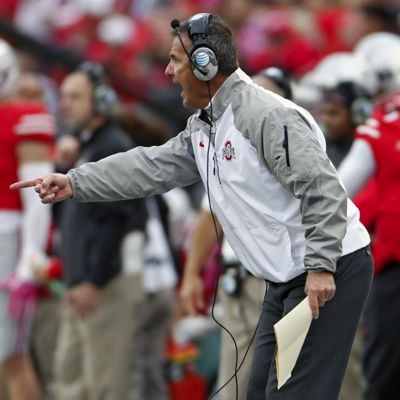
Prev
Next
Abolished the Huddle
One thing Chip Kelly perfected the no-huddle offense.
Seemingly, any kind of team is capable of running the no-huddle - spread offenses just have a lot more opportunities when they do so. You can catch the defense mid-substitution,or a with a player out of place, and score on a single quick strike.
The huddle is now becoming more and more obsolete, although many teams still do it.

Prev
Next
Tempo. Tempo. Tempo.
Another thing Kelly brought to football was an extremely fast paced brand of the no huddle that allows an offense to run a play ever few seconds. A team can run an exorbitant amount of plays with a minimal time of possession, all while racking up major points.
It used to be that the team with the greater time of possession won the game, but that trend is reversing.
When Kelly brought his rapid fire offense to the NFL, he proved it could work on any level of the game.

Prev
Next
Used the Spread as Run-First Offense
From LaMichael James to Ezekiel Elliot, there have been no shortage of successful rushers in spread systems.
More often than not, linemen line up far apart from each other. During the play, they employ zone blocking - double teaming members of the defensive front before breaking off to attack the second level.

Prev
Next
Made Linemen Leaner
Over the past ten years, broadcasters have often marveled at how lean and athletic the lineman on Urban Meyer's team's seemed to be. Instead of big, slow lugs down in the trenches, Meyer recruited athletic freaks with size and speed to compete for a spot on the line.
The Ducks did more or less the same thing (Bo Thran, Jake Fisher, Hroniss Grasu).
Now, Meyer prototypes like the Pouncy brothers are all-pros in the NFL and the lean lineman chasing down a safety is no longer a rare sight.

Prev
Next
Turned Receivers into Blockers
Receivers under Meyer and Kelly (and later, Helfrich) were expected to do one thing if they wanted to stay on the field: block.
The philosophy helped make receivers grittier than ever and led to an increase in big plays.
When you have players who break tackles and rack up extra yards after contact, like James and Tebow or, now Elliot and Freeman/Tyner, the big play ability of the ball-carrier is exponentially bigger with their team mates securing blocks downfield.

Prev
Next
Made Play Calling More Fun
Before Chip Kelly, calling a football play was a relatively boring routine. The quarterback would get the play from his coach while his teammates would huddle up, in two rows of five.
Looking each one in the eye at least once, the quarterback would say something like:
"Gun..trips right, zone right, cut. On one."
And that was it. That was a football play.
The process changed dramatically Chip Kelly broke out play-calling postboards divided into four, random quadrants.
Now, the process is much more fun for coaches, players and viewers. The play-calling posterboard has increasingly become the norm for a number of college teams.
There are goofy catch phrases, pop culture references, inside jokes and awkward close-ups of broadcasters.
It's fun, and people like it.
Related Articles
Enjoy this post? Share it with others.





 Email to a friend
Permalink
Email to a friend
Permalink

























Follow us on Pinterest Google + Facebook Twitter See It Read It